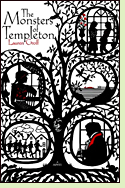The Monsters of Templeton
by Lauren Groff
Reviewed by Margaret Donsbach

Mostly set in the present day, The Monsters of Templeton includes enough chapters set in the eighteenth
and nineteenth centuries to count as a historical novel. It's funny and
heartbreaking, strange in a way that real life often is.
In the wake of a disastrous love affair, Wilhelmina "Willie" Sunshine Upton has returned to her childhood home in Templeton, a small town in upstate New York that is a fictional version of nineteenth-century novelist James Fenimore Cooper's hometown. In an introductory note, Groff tells readers that when Cooper himself wrote a novel about his hometown, "his facts also went a little awry, so he decided to rechristen his town Templeton, New York." Groff "relaxed and followed his lead."
As Willie arrives home, "the fifty-foot corpse of a monster" emerges from the local lake, looking "like a carp grown enormous, with a carp's fat belly and round eye, but with a long, articulated neck like a ballet dancer's, and four finned legs, plump as a frog's. The ropes of the motorboat had cut into its skin, and the wounds were open to the day, still oozing dark, thick blood.... And, though I had expected the early sun to have warmed it, the monster burned cold, as if its very core was made of the ice some said still existed at the bottom of our glacial lake."
Soon Willie, a descendant of the famous Templeton author Jacob Franklin Temple, has a compelling reason to research her family history. As she starts uncovering monstrous qualities in some of her ancestors, she nevertheless feels driven to keep researching, hoping to satisfy that craving for "a mass of ancestors at our backs as ballast." Because this is fiction, the ancestors, too, can speak. Readers who feel a craving like Willie's and have asked themselves why they want to feel connected even to ancestors who did awful things will find The Monsters of Templeton a compelling story. (2008; 361 pages)
More about The Monsters of Templeton at Powell's Books, Amazon.comOther novels about modern people researching their ancestors:
Angle of Repose by Wallace Stegner (1971), about a retired historian who researches his grandparents' hard lives and enduring marriage in late nineteenth-century California; won the Pulitzer Price for fiction in 1972. More info
The Physick Book of Deliverance Dane by Katherine Howe (2009), about a modern American woman who inherits her grandmother's house and discovers an ancestor of theirs was persecuted for witchcraft. See review or more info at Powell's Books
The Glassblower of Murano by Marina Fiorato (2008), about a modern London woman who moves to Venice and researches the story of her ancestor, a great glass artist. More info
Nonfiction about James Fenimore Cooper:
William Cooper's Town: Power and Persuasion on the Frontier of the Early American Republic by Alan Taylor (1995), about James Fenimore Cooper and his father, William Cooper, who founded Cooperstown, New York; won a Pulitzer Prize. More info
James Fenimore Cooper: The Early Years by Wayne Franklin (2007), about Cooper from his boyhood in Cooperstown, New York, to age thirty-six. More info
A Historical Guide to James Fenimore Cooper by Leland S. Person (2007). More info
Online:
James Fenimore Cooper at Wikipedia
Back to Novels of the Eighteenth Century
Back to Directory of Book Reviews